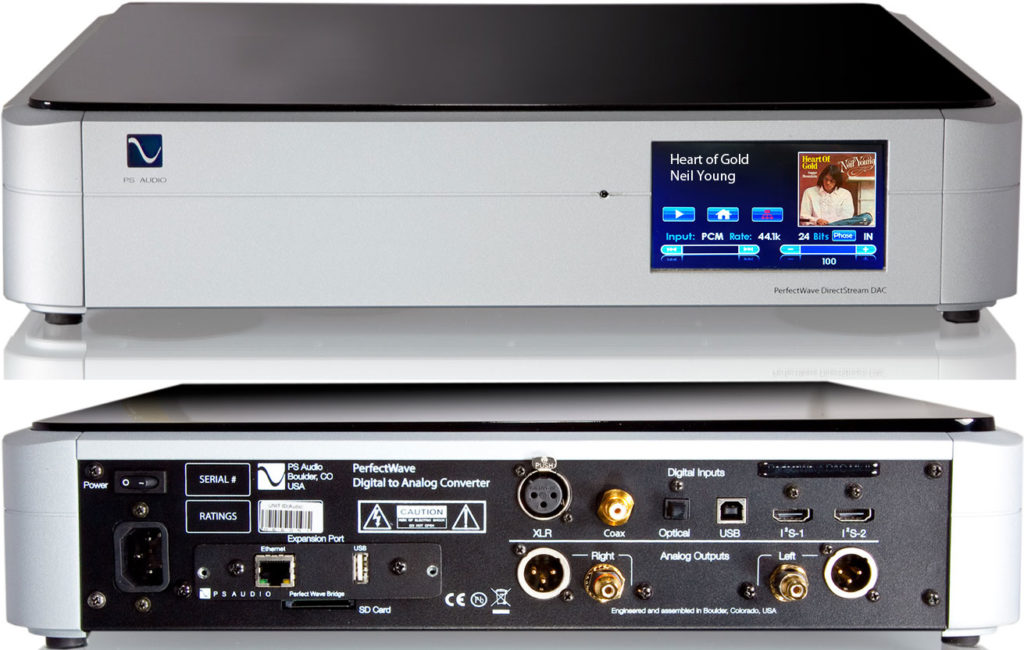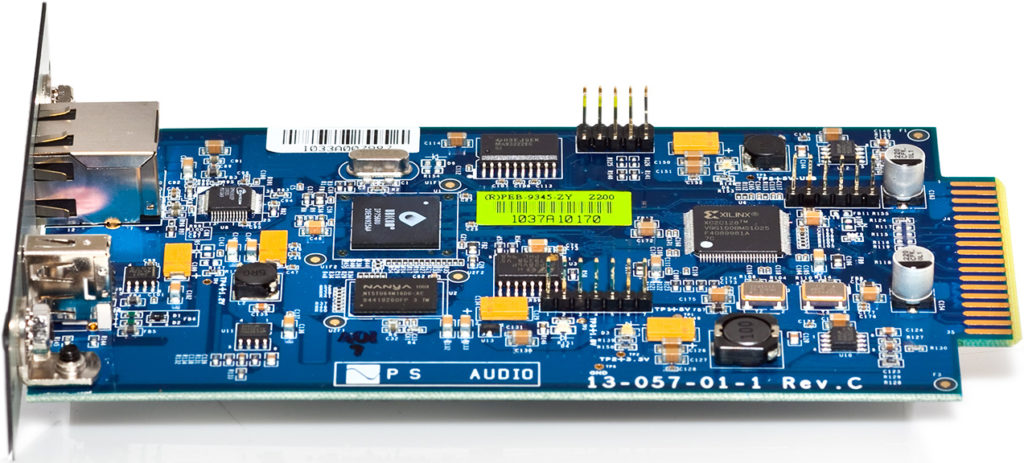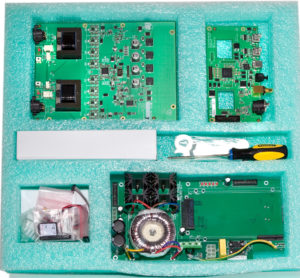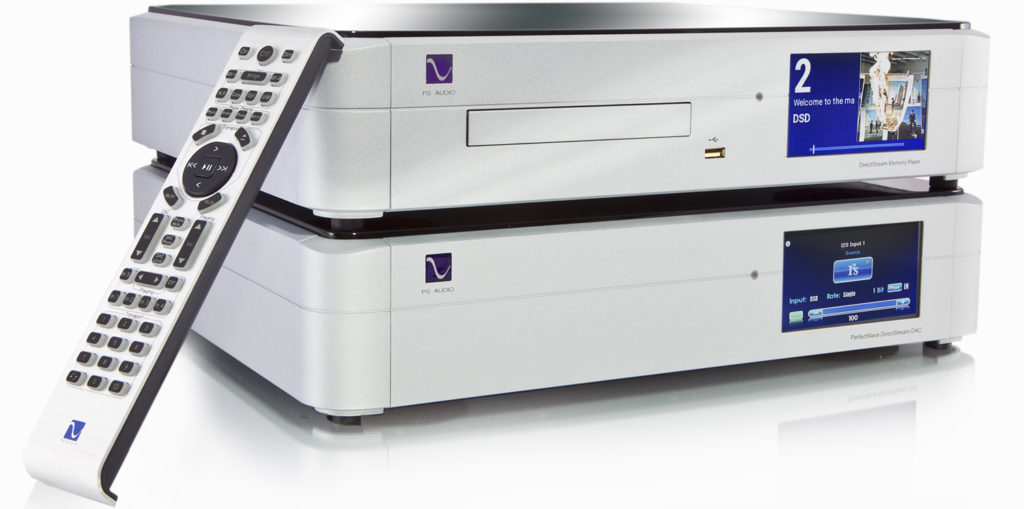DirectStream DAC
PS Audio’s DirectStream DAC is one of the most widely reviewed (and praised) products I can recall in the past 10 years and it was an instant hit with me. I don’t know how much I have to add, but because I have been living with one for a number of months, I’ll share some thoughts. First, I had tried this DAC for a short while a few years ago and, while I thought highly of it, I found it a bit syrupy sounding. I no longer feel that way, but in some ways it’s no longer the same DAC. Because the DS DAC uses an FPGA instead of the off-the-shelf DAC chips used in most DACs, PS Audio is able to continuously refine its sound and some of its capabilities and offer firmware updates that users can install easily with an SD card. Since introduction, perhaps six updates have been offered. The rate of updates seems to have slowed in the past 18 months, which I think is a good thing for anxious audiophiles.
This is not just another DAC. For one, it’s DSD based – incoming signals are up sampled to 10x the DSD rate of 2.8MHz before processing. After processing, data are converted to double rate DSD (5.6MHz) and output through the analog output section. For another, that analog output stage is passive via output transformers. But there are many, many other aspects of this product’s design that reflect careful decisions made to solve problems. The user manual for the DirectStream DAC includes a terrific whitepaper-like discussion of design choices. It is brief, well written, accessible and available as a download from the PS Audio website. I highly recommend it, even if you are not interested in this DAC.
Like the Memory Player, the interface to the DAC is via a 4.4” touchscreen or via the remote. Optional at $899 is the PerfectWave Network Bridge II board for this DAC. This is a user-installable add-in that allows the DAC to serve as a network player and streamer by giving it an Ethernet input and associated capabilities. I was and am very excited about the Bridge II. Instead of rendering Ethernet from my Mac Mini via the Sonore microRendu, I can go Ethernet straight into the Bridge II in the DSD DAC and remove those extra components (microRendu and power supply). Like the microRendu, the DS DAC is a Roon endpoint, but unlike it, it fully unfolds MQA. And it has Digital Lens technology built in. If you are doing any file playback or streaming, the Bridge II with your DS DAC seems a no-brainer.
Elegant is a word I’d use to describe the sound of the DirectStream DAC, as well as the sound of DSD. It was highly resolving of detail, which I noticed for the expansive soundstage and exceptional retrieval of ambient information. But rather than being aggressively detailed as some modern DACs were, the DirectStream was very smooth and even a touch sweet, the latter possibly attributable to the transformers in the analog output stage; I heard a touch of sweetness from good transformer-based preamps. This combination yielded a quality of refinement that makes me think ‘elegant.’ The DAC tends to a mid-hall perspective as opposed to up close (I much prefer mid-hall myself) and has a slight quality of composed restraint or politeness (only slight), but it’s never laidback or boring.
For comparison, I’ll comment on the Schiit Yggdrasil, which I have not formally reviewed but which has been my personal DAC for a few years. The Yggdrasil costs less than half what the PS Audio costs ($2,399 currently vs. $5,999). But Schiit sells direct, so that’s one factor to level the playing field. Another is that the PS Audio does a lot of things the Schiit won’t, such as play DSD, offer volume control so you can connect directly to your amp(s), and, with the Bridge II, unfold MQA.
I can see how some listeners might strongly prefer one to the other as they do sound different, but I have to say that I love both of these DACs; they are the two most enjoyable I have had in house. The DS DAC is a champ when it comes to recreating soundstage depth and ambiance, the Yggdrasil less so. Where the PS Audio is refined and elegant, I would characterize the Yggdrasil as more freewheeling and, perhaps, raw. The Yggdrasil sounds a bit bottom-heavy than the DSD DAC, giving it a slightly more full-throated sound, though this is a very subtle difference. Compared to the mid-hall perspective of the DirectStream DAC, the Yggdrasil tends to have a closer perspective, but not always. Dylan’s The Bootleg Series, Volumes 1-3 features a rehearsal version of “Idiot Wind” that’s a real knockout. Less forceful and angry than the version on Blood on the Tracks, Dylan’s delivery of the lyrics is impeccable and gripping. The PS Audio places his voice closer and more in the room than the Yggdrasil, but both deliver the goods on this recording.
I notice that the Yggdrasil has less of what I would call sheen to its sound, while the PS Audio has more, but only in comparison. Is this absence of sheen what people refer to as the absence of ‘digital glare’? I’m not sure. Exaggerating for the purpose of illustration, think of this as the difference between an extremely clean window and an open window. I see the appeal of the lack of sheen, but I have always thought that the slightly Windex-y quality of digital is a large part of its mainstream appeal. True or not, it evokes greater ‘clarity.’ Interestingly, I recall having a similar response on first exposure to moving coil cartridges, which I heard as having greater clarity compared to moving magnet designs, but also more sheen.
Picky-Picky
If I have one area of complaint about these two PS Audio products, it’s the displays on them. As mentioned, both have front-panel touchscreens you use to operate them, and they are also operable via the remote, where one remote will control both products as well as some other PS Audio products, and it’s a very good remote. I don’t know enough about display technology to appreciate why PS Audio may have chosen what they did for these products, but as a consumer I would say these displays deliver a disappointing user experience. Album art looks decent, but system text and graphics are ugly. Microsoft Windows 1.0 ugly, which, here in 2018, is, shall we say, unexpected. You can ignore the displays and rely on the remote for many things, but not for everything.
Apart from the aesthetic issue, which is hardly a deal breaker, there are readability concerns, especially with the DAC. I sit about 10 feet from the gear and at a slight angle. Some of the text is easy to read from that distance, such as volume level on the DAC, track number of progress on the Memory Player, but there are some other things that I cannot see well from my listening position. One is file type and resolution – I would like to see if I am listening to PCM or DSD, 16/44.1, 24/96, etc., but that text is too small, at least for me to read easily from my seat. The other is polarity. The remote has a polarity button, which is a nice feature for those who can hear the difference. I am usually not one of them. But there is no polarity indicator on the remote and the one on the DAC’s display is smallish text that reads ON or OFF. I can’t see it confidently from where I sit to listen, which means it’s easy to get confused about what ‘state’ the DAC is in. Use of a symbol or color might work better, as would moving this indicator to the upper right corner. PS Audio: if this is an easy fix, please make it so!
If I may climb on the soapbox for a moment, I wonder about the value of displaying album art on these devices. I can’t single out PS Audio because everybody seems to be doing this, but I don’t get it, personally. It strikes me as well intentioned, I suppose, but bordering on gratuitous. If I’m playing a CD, I have the physical CD case I can look at. If I’m playing a file, I am usually controlling it from a tablet that shows me the album art, and more than that in the case of Roon. It’s nice to see the name of the recording or track displayed on the transport or DAC, assuming the text is readable from a distance, but the album art? You may feel differently.
Conclusion
PS Audio Founder & CEO Paul McGowan has said that they are working on a server product but will not release it until it sounds as good or better than the Memory Player. Curiously, there’s a statement in the Bridge II product pages on the PS Audio website implying that file playback may be even better than the Memory Player. Paul’s got a good system up there at altitude in Boulder, Colorado, and he’s got good ears. Kudos to him for taking this position instead of putting a server out there just to make sales. Although I consider Paul one of the most skilled marketers in high end audio, I think he is genuinely on the same geek journey the rest of us are and his products reflect an honest attempt to move the ball down the field in their respective categories. Given what the company is currently offering for digital playback, the paths they’ve forged with Digital Lens, FPGA and I2S, the number of years they’ve been at this game, the relatively good value they offer (the products aren’t cheap but neither are they insane), not to mention excellent customer support (including a robust user forum), innovative sales practices (generous trade-ins, in-home trials), I can’t think of a company I’d be more comfortable hitching my digital wagon to than PS Audio. The DirectStream Memory Player and DAC are, without question or reservation, exceptional products worthy of your serious consideration.
Associated Components
Speakers: Harbeth Monitor 30.1, Zu Audio Omen Dirty Weekend
Preamps: PS Audio BHK, Music First Baby Reference
Power amps: PS Audio BHK Stereo, Pass Labs XA30.8
Digital file playback: Mac Mini running Roon Core out via Ethernet to PS Audio DirectStream DAC with Bridge II; or out via Ethernet to Sonore microRendu (with Uptone LPS-1 power supply) and then via USB to the USB input on either the PS Audio DirectStream DAC or the Schiit Yggdrasil DAC
Speaker cables: Duelund DCA-16 awg roll-your-own; Triode Wire Labs American Speaker cable
Interconnect cables: Nordost Tyr, MG Audio Design CU2, Cardas Clear Light
Digital cables: Benchmark AES/EBU, Audioquest Cinnamon Ethernet; Audioquest Cinnamon HDMI for I2S, Curious Cables USB
Power conditioning: Audience aR6-T with AU24 SE power cord
Power cables: Audioquest Tornado, Triode Wire Labs, Acrolink with Oyaide connectors, various Pangea
Manufacturer’s comment:
Thanks so much to Dan Rubin for his thorough review of the DirectStream DAC and the DirectStream Memory Player (DMP). Dan’s experiences with both units ring true; certainly, we strive to improve both when possible, so as to assure that our customers receive the benefits of all we’ve learned during the never-ending process of development.
One of the major benefits of the FPGA-based design of both the DIrectStream and DSJ DACs is that digital guru Ted Smith can reconfigure the FPGA to take advantage of everything he’s learned along the way. I’m not sure which OS Dan’s DirectStream was running—I’d suspect RedCloud—but we recently released Snowmass, which is to my count the 11th OS upgrade in the 4 ½ years since DirectStream was released. Snowmass is, not surprisingly, the best OS yet: noise is so low and soundstage so deep that sounds just seem to leap out of nowhere.
Honestly, no hype: it’s great stuff.
We appreciate Dan’s experiences with the user interfaces and displays, and we are working on them. There should be a firmware upgrade available for DMP before the end of the year.
We know that buying a DAC and transport isn’t an inconsiderable investment: we do the best we can to make sure that our units will not only perform for years to come, but will actually perform better five years from now, than they did when purchased.
PS does whatever we can to ensure that obsolescence is obsolete.
Thanks again to Dan for his efforts, and to Constantine for publishing this lengthy review.
—Bill Leebens
Director of Communications, PS Audio
- ← Previous page
- (Page 3 of 3)





For a guy who enjoys streaming Tidal, you seemed to miss the great function of the Bridge on both units. I am using my iPad to control the bridge using mConnect app for both Tidal MQA and also vTuner internet radio. With the vTuner, you have thousands of radio stations at your disposal for streaming through the DAC. My Harbeth speakers are doing a great job along with my Bryston integrated amp., all bought through Andy Singer at Singer Sounds in NYC. It is a very balanced synergistic system! I hardly ever bother with CDs anymore myself!
Thanks for your comment, Alan. I’m not sure I understand your point, though. I use Tidal integrated with Roon, so they both originate from the Mac Mini and I control them with the Roon app on an iPad. Are you suggesting I should instead access Tidal directly via the Bridge on the DS DAC? Not sure I see an advantage, especially since Roon-Tidal integration is a “killer app” as it is, but let me know what you are thinking. Also, when you say, “the great function of the Bridge on both units,” what are your referring to with respect to the Memory Player?
Regards,
Dan
Thanks for the great review. Were you able to compare the Bridge II ethernet playback from your mac mini compared to the MicroRendu and power supply?
Hi Shahram and thanks for your comment. I did compare the two and found it to be fairly close, but I am taking a second listen to that comparison this week. I didn’t want to complicate the main review by addressing it, but it is a worthwhile topic. Given the added expense of the microRendu plus power supply (~$1K), it would need to clearly better the Bridge to be justified, assuming you already have the Bridge.
I’ll add that over the many years I’ve been playing with computer audio, I feel the microRendu is the most significant sonic improvement of any I’ve tried, including DACs, cables, the Berkeley USB converter, and many different playback software products. Then, adding the LPS-1 power supply was almost as great an improvement on top of it.
Dan
As PS Audio is being discussed: How about one of their Power Regenerators?
Nice review, Dan.
I’m confused by this, in reference to the DS DAC: “Instead of rendering Ethernet from my Mac Mini via the Sonore microRendu, I can go Ethernet straight into the Bridge II in the DSD DAC and remove those extra components (microRendu and power supply). So, I don’t need my ultraRendu/LPS with the DS DAC? That, if I connect it via Ethernet to my file sources, the DS DAC becomes the renderer/player? If true, then IMHO, this is not made clear/explicit in the PSAudio literature. “This is huge, Jerry … HUGE!”
Thanks
Thanks for the kind words, Hoyt. Also, bonus points for the Seinfeld reference, which always scores big with me.
What you are saying is true, but see my reply to the comment above. I agree that PS Audio may benefit from underscoring this benefit more explicitly in marketing materials. I also sympathize with all players in this field (including and especially consumers) as they struggle to talk about this stuff. File playback and streaming services have ushered in a level of complexity and confusing terminology that’s hugely more challenging than anything we have seen in audio ever. Or maybe it’s just me.
Dan
No, there’s a lot of complexity, arcane terms, acronyms, obtuse {abstruse?} terms & references. This, these phenomenon are by no means confined to music reproduction, in general, to, Audiophile – Fidelity. Exaggerated, “highfalutin,” terms; to try to keep from going insane, must ascribe to, “marketing;” “Snake Oil,” is more polite than the equally applicable: Lying. Gross Exaggeration. “Out of Whole Cloth.” “I don’t know just what that fancy new term means, but the verbiage certainly sounds impressive! MUST mean something!” Oh, yeah?! Here’s one, for free! `Impedance Phase Alignment Compensation!’ Pretty good, eh?!
Dan,
It is not just you. Your observation is spot on. I am being driven crazy by the terminology and layer upon layer of details and caveats/stipulations/debates amongst those supposedly “in-the-know” about computer audio and how it should be or needs to be done. One audiophile will profess with authority how a usb connection is total garbage for a server/streamer, while the next guy says “nope” it isn’t. And debates like that are the least of my concerns at this point. After following this stuff for a while, I’ve learned a thing or two. I disagree with the “USB is always crap” crowd. But most frustrating is that I’ve found no one so far that speaks about CA in terms that are plain-spoken instead of computer-ease. I’m beginning to tease it out for myself, but it should not take so much effort and time. It’s a shame that among those with a great command of the topic, so few are willing or able to explain it in terms any audiophile could grasp. Messaging with a fellow audiophile on the topic, he said to me with a straight face: ” The issue with Roon is that unless it is being run with HQ Player, the native Roon renderer isn’t as good as the Aurender renderer/hardware combo.” That sounds like audio talk. Not. It almost seems like intentional subterfuge. Lol. It’s not like we are an unmotivated bunch. Many of us very much want to learn the topic so we can make informed buying decisions in pursuit of better and better audio experiences in our rooms. And despite being highly motivated the learning is difficult because the teaching is, IMO, quite poor. Or, alternatively, to quote a wise man, “maybe it’s just me.”
I began studying Basic Electronics in the U. S. Navy, in January, 1968. Continued, re – studied several times, since then. Initially, had seen tubes; transistor circuits weren’t sophisticated, yet. Didn’t know between components, couldn’t tell a resistor from a capacitor from an inductor. Had a vague idea what a large, heavy transformer was. And yet: I encourage you, everyone to LISTEN to systems, in an Audio Salon, an environment as close as possible to yours!
Rick,
Excellent comments, very well said. I’m giving thought to trying to come up with a simplified, plainspoken overview of the category myself, not because I’m the right person for the job but because somebody has to do it.
Dan
Please do! I’ve avoided CA because of the complexity. Too me the headaches weren’t worth any benefits I might have received.
Have you tried Windom ?
Hi, can I stream music via my phone through streaming apps like Deezer? Airplay etc.?
Fahad, The DirectStream DAC is capable of streaming through its Bridge Network input, hard wired ethernet connection required. It is capable of accepting streams from Tidal, Spotify, Qobuz and also act as a Roon endpoint. Unfortunately we don’t have compatibility with Deezer or Airplay at this time.
It’s time for me to completely update my audio system, this time to CD, SACD. I like the Dudes, `Dude – ettes,’ at PS Audio, their CD Transport has received fine reviews, there recently was a sale, therefore I took advantage of this. Straight PS Audio, I’m suspicious of mixing brands unless necessary; for example, the forthcoming PS Audio speakers are not quite yet available {I’m old – I hope that they pick up the pace! It’s been years!}, & there’s no immediate design for subwoofers. I also, `threw in’ the P20 Power Regenerator {figurately – it’s heavy!}, `The Regurgitator,’ their I2S connector between the Transport & the top DAC, then Balanced XLR’s between the audio analog components / stages. {Isn’t this what the, Z Z Top recording, “Stages,” is concerned with?} Also purchased, for you streaming buffs, {And, we know who you are!} the Network, Bridge Option Input Card. Because there are some things that I simply can’t find, to buy! When this is finally installed, you’ll know – I’ll just turn up the Subs, a bit! Or, could be the next, San Andreas!
Actually, saying the DS DAC output stage is passive is kind of misleading. There is a transformer on the back that blocks DC. And some might argue, some ultrasonic content. And yes that is a passive output device. But the actual low pass filtering d/a conversion, the important part, occurs in a high speed op amp array (4x/channel) that drives the transformer.